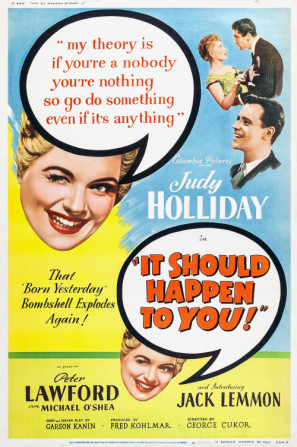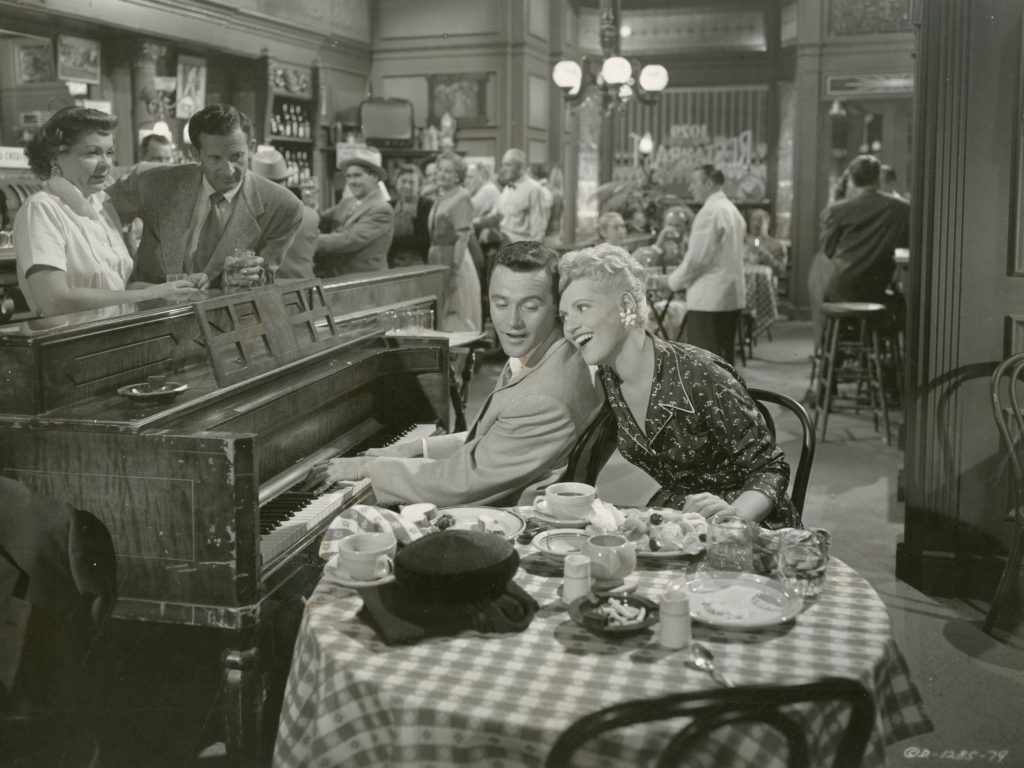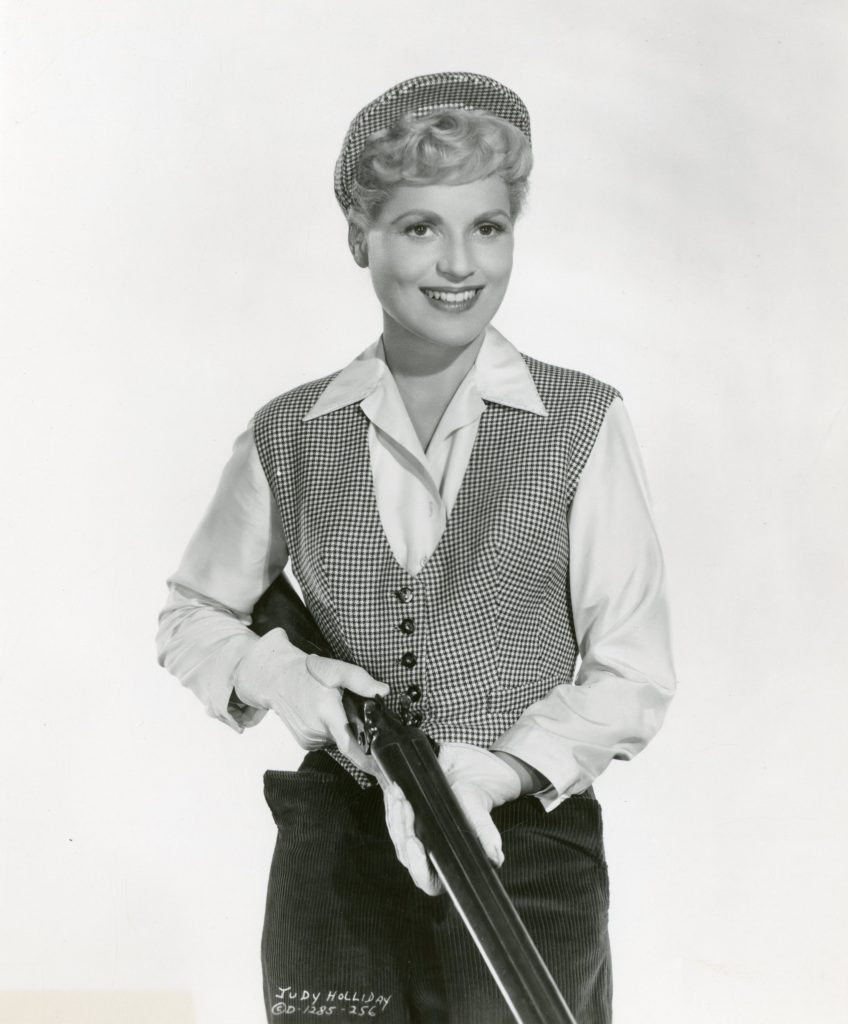Week of March 8 – 14, 2020
My second choice for a feel-good film is an oldie from 1954 with the stellar talents of comedienne Judy Holliday and a new face at that time, the one and only Jack Lemmon, making his film debut. And let’s not forget that this charming comedy / satire is directed with his usual wit and cleverness by George Cukor, one of Hollywood’s finest directors, especially regarding aspects involving women. Cukor’s greatest talent was taking any story, whether it be social strata (Dinner at Eight, My Fair Lady), marriage and divorce (The Women, The Philadelphia Story, Adam’s Rib) or even athletics (Pat and Mike) and finding ways to meld a female perspective or point of view into the proceedings, with the finest taste and delicacy. Cukor made some of the best “women’s pictures” around, working with the likes of Joan Crawford, Greta Garbo, Katharine Hepburn, Judy Garland, Constance Bennett, Lana Turner and many others over his long career. He worked with Judy Holliday five times, directing her to an Oscar for Born Yesterday in 1950; It Should Happen to You was their last film together.

The movie finds girdle model Gladys Glover (Judy Holliday) out of work because she has gained a few pounds. As she strolls shoe-less through Central Park she meets a documentary filmmaker, Pete Sheppard (Jack Lemmon) who instantly falls for her. Something he says inspires Gladys to truly make a name for herself, using much of her savings to rent a Columbus Circle billboard featuring only her name, for three months. Pete is aghast at her waste of money, but Gladys is certain that fame and fortune are awaiting her just around the corner because of her savvy self-promotion. Indeed, she parlays the one billboard into six others, and then an advertising campaign featuring herself as the “Average American Girl” who exclusively relies on Adams soap. A personal appearance tour follows, and more advertisements and with those, Gladys begins to realize the sense that Pete was making about the hollowness of fame. What will she do?
Pete cannot understand why Gladys is so fixated on becoming famous, being “above the crowd” as he calls it. Gladys, on the other hand, doesn’t understand why everyone doesn’t wish to be famous. She wants to live a life as a public figure, known and admired, perhaps adored, because that’s how she sees herself, far away from the ordinary, downtrodden existence she had working in a shoe factory in Poughkeepsie, where she would be expected to marry the first or second man to ask her. In this, the film is way ahead of its time, demonstrating in the 1950s what has become so prevalent in the 2000s, as people now become famous for no good reason at all, due merely to exposure on television, in advertising or on the internet. Gladys tastes the big time simply by putting her own name on a big billboard, which fools some folks into thinking she is a big name. In one amusing sequence, one of her billboards outside a store window leads to an impromptu autograph session that pushes Pete further away from her.
Unlike today, wherein the fame seems to perpetuate itself and the famous do all that they can to remain in the spotlight no matter what, Gladys has an epiphany and rejects the fame game. Finally having had enough of selling her soul for products she neither believes in nor uses, Gladys realizes that real life is passing her by, and the one man who made her happy has given up on her. Pete is still doing his thing with his documentary camera when Gladys gives him a sign, one that even he can understand, and the requisite happy ending follows. Gladys eventually rejects the hypocrisy and constrictions of fame, and it is the right decision, but I wonder how many viewers would have done the same, in her position. Perhaps I am wrong in thinking, as Pete Sheppard does, that fame is an empty, illusory version of life. Perspectives have certainly changed since the time this movie was made; viewers now may not agree with the film’s moral values at all. (See it, and decide for yourself!).

But this is a comedy, and a love story as well. Pete is not the only man to fall for Gladys; so does Evan Adams III (Peter Lawford), heir to the Adams Soap fortune. It is Evan’s negligence which allows Gladys to get the Columbus Circle billboard in the first place, and his efforts to get it back include a little wining and dining, and tooling Gladys around in his sleek Jaguar sports car. Evan is accustomed to getting what he wants, and he goes after Gladys with some gusto, self-assured that no one else can offer her what he can. Gladys chooses Evan over Pete a couple of times because she thinks of his attentions as “business,” but she eventually learns how Evan likes to mix business and pleasure. The innuendo piles up pretty quickly, finally scaring Gladys back to a more sensible mode of thinking, and back to Pete. Evan represents a fun, romantic diversion, but not much more than that, and Gladys decides that she wants something much more substantial in a romantic relationship.
The humor of the piece builds from Gladys, who is not in the least an “Average American Girl,” doing next to nothing but becoming famous and admired anyway. Her little billboard experiment leads to a career she doesn’t really want, a romantic interlude, situations she could never have imagined and a test of her scruples for which she never asked. How Gladys reacts to all of this is charmingly portrayed by Judy Holliday, one of the movies’ brightest stars who had a brief but hugely successful film career. Holliday is a physical actress unafraid to let herself appear silly or self-conscious. She can talk tough or smile sweetly, making audiences laugh either way. Her voice is amazing; she can growl like a tiger or sing with a light touch — her inflections are always spot on. Watch how she enjoys a little romantic ear-play with Peter Lawford; after she realizes she likes his nibbling, she nonchalantly removes her earring herself as encouragement for him to continue.
Holliday’s Gladys Glover is a modern woman still trying to determine who she is and what she wants. Fame is a big part of it, but so is happiness, and that is represented by Pete. This was Jack Lemmon’s first film and he is incredibly assured and personable (he also stars with Holliday in his second film, the awfully-titled Phffft, also in 1954). Lemmon offers a restrained performance that nicely balances Holliday’s lovable kookiness. Add Peter Lawford’s suavity and the result is a charming mixture of romance and comic circumstance, the kind of movie that isn’t made much any more. Judy Holliday was a one-of-a-kind performer, but Goldie Hawn (though without the musical talent) was able to develop a similar kind of persona in her comedies.

If you’ve never seen a Judy Holliday film, I think this one would be a good place to start. It feels contemporary, even if its conclusions may not reflect how people would act now. It isn’t as stage bound as Born Yesterday (1950) or as old-fashioned as The Marrying Kind (1952) or Full of Life (1956). I do prefer The Solid Gold Cadillac (1956) and Bells are Ringing (1960), but those are different types of films. At least Bells are Ringing is. This film is on DVD and is available for streaming as well. Ultimately, any one of these will do to brighten your spirits, because that’s what Judy Holliday could do, perhaps better than anyone else of her era. She was pretty, plucky, personable and very, very talented. Her movies are full of fun and joy and occasionally some sadness, and they make you wish that you knew her in real life. She has that kind of empathy and attractiveness. She makes you feel better about life. ☆ ☆ ☆. Backdated to 8 March 2020.
Similar movies include Born Yesterday (1950); Protocol (1984); The Solid Gold Cadillac (1956); and probably others which I am unable to identify at the moment.
